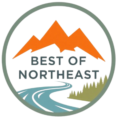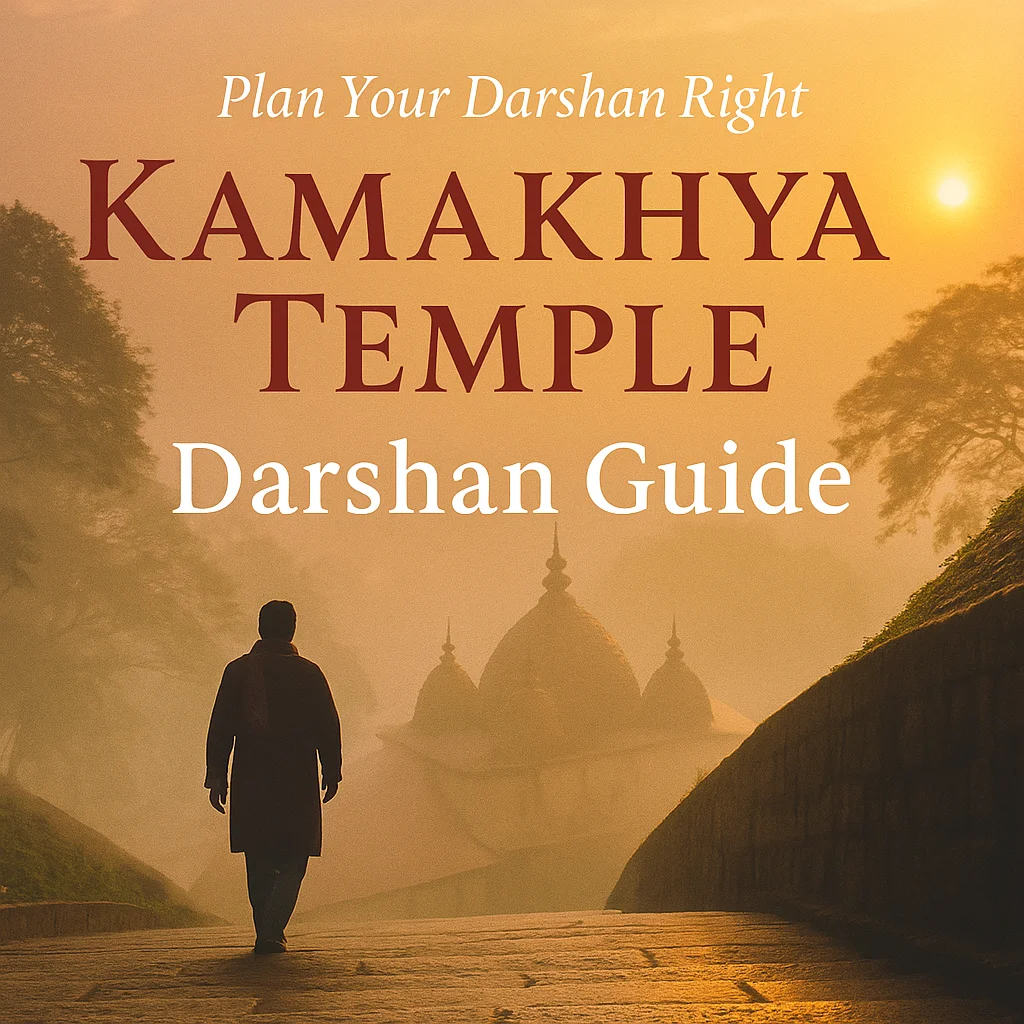While most travellers flee the rains, Northeast India comes alive during the monsoon. This comprehensive guide on Northeast Monsoon Travel reveals why the wettest months (June-September) unlock the region’s best-kept secrets: living root bridges that strengthen with every storm, waterfalls that transform into thunderous curtains, and tribal comfort food that tastes better with a side of rain. Pack your sense of adventure—we’re diving deep into monsoon magic.
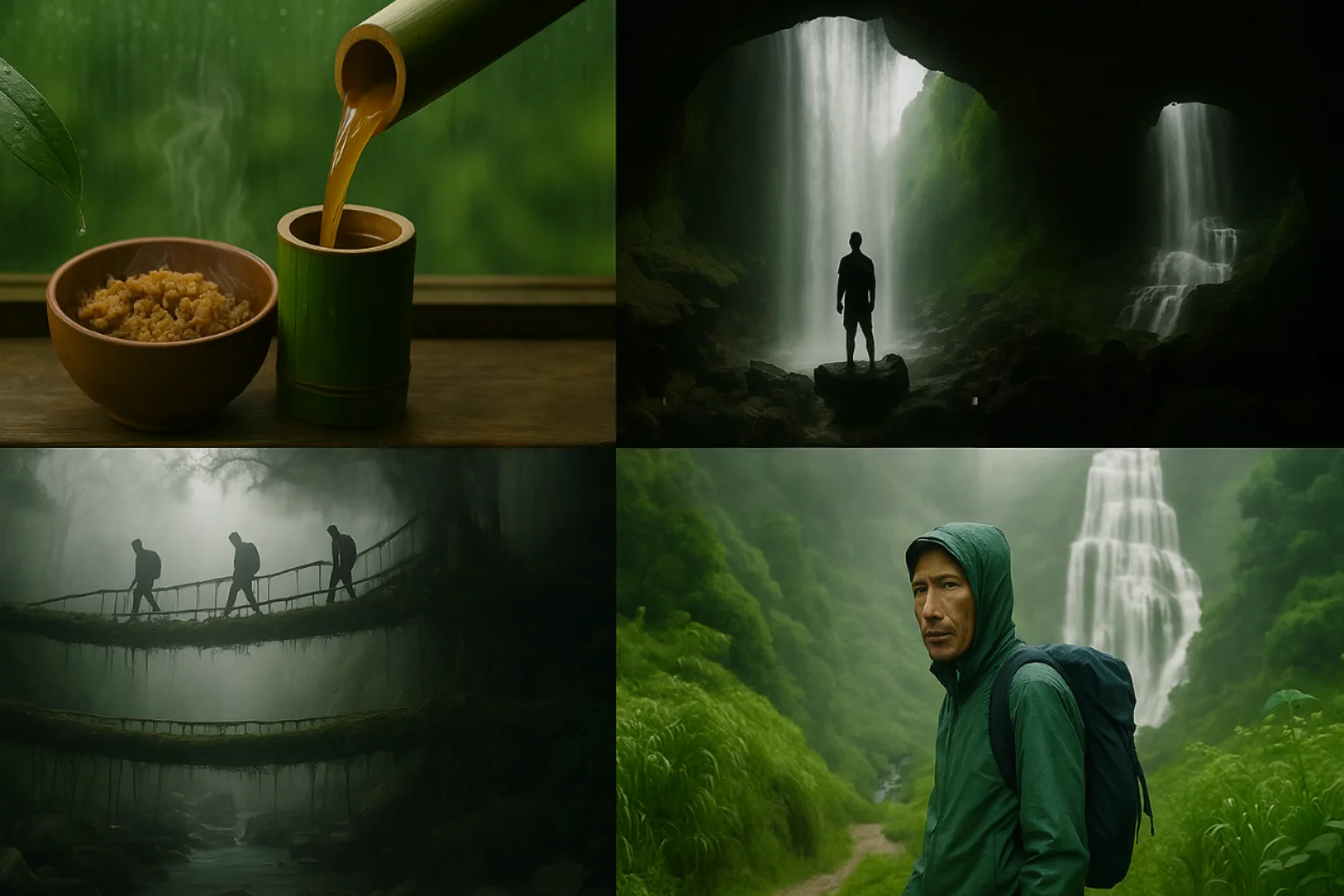
Table of Contents
1. What Makes Northeast Monsoon Travel So Special?
Forget gloomy skies! Northeast India transforms into a mythical wonderland from June to September:
- 🌿 Emerald Landscapes: Rain breathes life into rainforests, turning valleys green
- 👣 Crowd-Free Exploration: Tourist numbers drop by 60%
- 🎉 Cultural Vibrancy: Experience festivals like Meghalaya’s Behdienkhlam (July)
- 🦜 Wildlife Spectacles: Spot rare orchids and Blyth’s tragopan birds
Khasi Monsoon Wisdom
Locals believe heavy rains come when the Diengiei (forest spirits) wash their hair. Rainbow halos around waterfalls signal their presence.
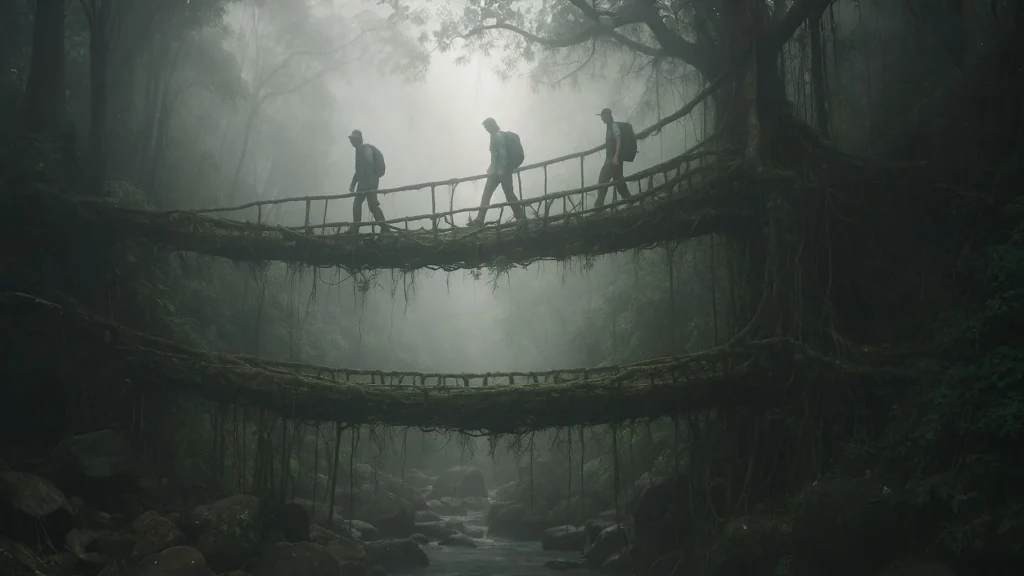
2. Meghalaya: Where Rainforests Come Alive
2.1 The Living Root Bridges
Hand-woven by Khasi tribes over 15-30 years using Ficus elastica roots, these UNESCO-tentative wonders:
- 🌱 Grow stronger with time, outlasting steel bridges in landslides
- 🦥 Host 400+ species including clouded leopards
| Bridge | Location | Trek Difficulty |
|---|---|---|
| Double Decker | Nongriat Village | ⭐⭐⭐ (3,000 steps) |
| Rangthylliang | Near Pynursla | ⭐⭐ (1.5 hours) |
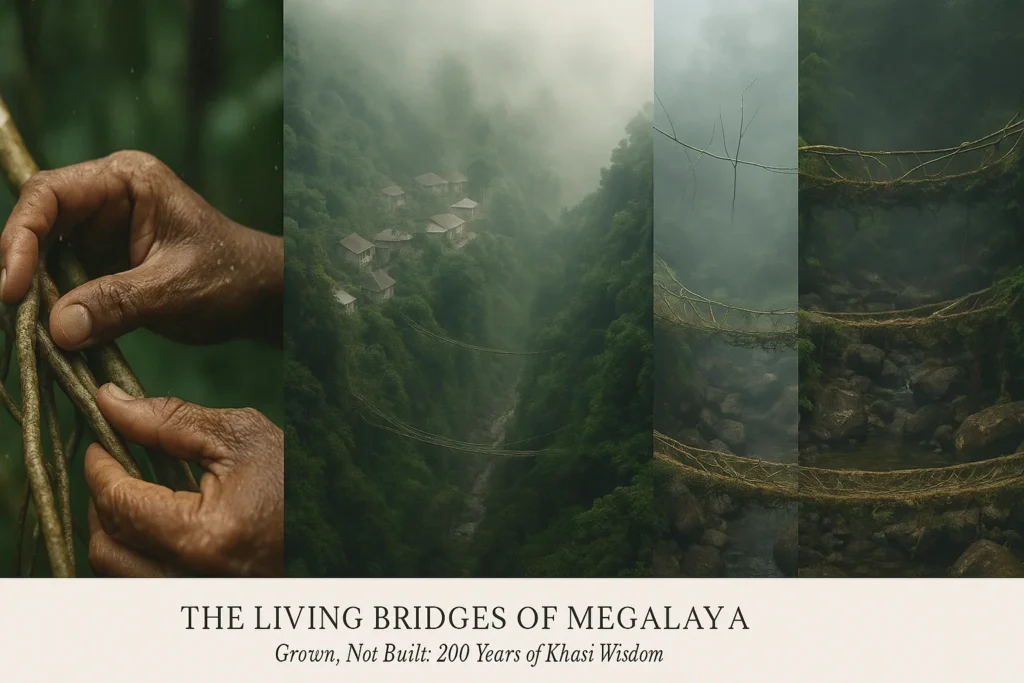
3. Mizoram: Land of Thunderous Waterfalls
3.1 Vantawng Falls
Named after legendary swimmer Vantawnga, this 750-ft waterfall:
- 💦 Peaks June–September with thunderous cascades
- 📸 Best views from the observation tower
- 🚗 3-hour drive from Aizawl
4. Monsoon Safety Hacks

Essential Gear
| Footwear | Waterproof boots + anti-leech socks |
| Health | Antifungal powder, rehydration salts |
Pro Tips
- 💸 Carry ₹3,000+ cash – ATMs often fail during downpours
- 🧭 Use Maps.me offline for landslide-prone zones
- ☎️ Local guides: Contact Meghalaya Tourism (+91 8787455505)
5. 7-Day Monsoon Itinerary
Day 1-2: Shillong
- Explore Ward’s Lake & Elephant Falls
- Try Jadoh (spicy pork rice) at local eateries
Day 3-4: Cherrapunji
- Trek to Double Decker Bridge (3,000 steps)
- Visit Nohkalikai Falls (340m drop)
Day 5-6: Mizoram
- Fly to Aizawl → Vantawng Falls day trip
- Explore Bara Bazaar for Mizo shawls
Day 7: Departure
- Mizoram State Museum visit
- Evening flight from Lengpui Airport
6. Tribal Culture & Festivals
Khasi Traditions
- 🎭 Behdienkhlam Festival (July): Bamboo pole dancing to drive away evil spirits
- 🍯 Khasi Honey: Buy directly from Mawlynnong village beekeepers
Mizo Rituals
- 🍵 Bamboo Tea Ceremonies: Elder women serve kawr for “rain sickness” protection
- 🧶 Puan Weaving: Watch artisans create traditional shawls in Aizawl

7. Where to Stay
Meghalaya
- Shillong: Ri Kynjai Serenity Resort (lake views)
- Nongriat: Serene Homestay (basic, near bridge)
Mizoram
- Aizawl: Hotel Regency (mid-range, city center)
- Thenzawl: Tourist Lodge (simple, near Vantawng)
Travel Responsibly
- 🙏 Respect bridges: Stay on designated paths
- 🌱 Support locals: Book homestays, buy handicrafts
- 📡 Check alerts: Follow @MeghalayaTourism for updates
8. FAQs for Northeast Monsoon Travel
Is it safe to travel during the monsoon in Northeast India?
Yes — with proper preparation. Most highways and tourist routes stay open, but Meghalaya and Mizoram have landslide-prone stretches. Always check IMD rainfall alerts and follow local advisories before visiting waterfalls or trekking to root bridges. Hiring a local guide significantly increases safety.
Which month is best for Northeast Monsoon Travel?
July and August offer the most powerful waterfalls and greenest landscapes.
June → slightly gentler rains, good for beginners
September → clearer skies, fewer tourists
Do the root bridges stay open during heavy rain?
Yes. Meghalaya’s living root bridges remain open through most of the monsoon because the roots actually strengthen when wet. The challenge is the slippery approach trails, especially the 3,000-step Nongriat descent, so avoid trekking during thunderstorms.
Can first-time hikers do monsoon treks in Meghalaya?
Yes — if they choose easier routes.
Recommended beginner-friendly options:
Rangthylliang Root Bridge (Pynursla)
Short rainforest trails around Cherrapunji
The Double-Decker Bridge is doable but physically demanding. Waterproof shoes and trekking poles help a lot.
What should I pack for a Northeast Monsoon Travel?
Essential monsoon gear includes:
– Waterproof boots + anti-leech socks
– Light, breathable rain jacket
– Antifungal powder & ORS
– Dry bags (waterproof bags) for electronics
– Offline navigation (Maps.me)
– ATMs may stop working during storms, so carry ₹3,000–₹5,000 in cash.
Are waterfalls accessible during the monsoon?
Generally, yes. Major sites like Vantawng Falls (Mizoram) and Nohkalikai Falls (Meghalaya) remain accessible. However, viewing decks may close briefly during intense rainfall. Always check Mizoram Tourism’s monsoon advisories for updated conditions.
Can I photograph waterfalls during peak rain?
Absolutely. Monsoon brings peak water volume and dramatic mist. Carry:
– Microfiber cloth
– Lens hood
– Waterproof phone pouch
Drone usage around Cherrapunji and Aizawl may require government or local authority permits.
Do tribal festivals happen during the monsoon?
Yes. Two monsoon-season highlights:
– Behdienkhlam Festival (July) in Meghalaya
– Bamboo tea ceremonies in Mizoram villages
Visitors are welcome if they follow local customs and photography guidelines.
What food should I try on a monsoon trip?
Top monsoon comfort foods:
– Khasi jadoh (pork rice)
– Dohneiiong (black sesame pork)
– Mizo bai (steamed vegetable mix)
– Kawr (traditional bamboo tea)
Many travelers say these dishes are the “soul-warming heart” of Northeast Monsoon Travel.
Are flights affected by heavy rain?
Sometimes. Airports at Shillong, Aizawl, and Lengpui operate through the monsoon but may face short delays during cloud cover or heavy rain. Keep some buffer time if you’re connecting to remote districts.
How many days do I need for a monsoon trip?
A 7–9 day itinerary works well for Shillong → Cherrapunji → Mizoram. Extend if you plan multi-day treks or deeper cultural experiences in Mawlynnong, Pynursla, or rural Mizoram.
Are homestays open during monsoon?
Yes, almost all homestays operate during monsoon — and many offer cultural experiences such as weaving workshops, bamboo tea sessions, or local storytelling. Book through Meghalaya Ecotourism or community-run lodges in Mizoram.
Can I self-drive in the Northeast during monsoon?
Possible, but not ideal unless you’re very confident with hill driving. Visibility drops quickly during downpours, and local drivers know how to navigate landslide zones safely. Hiring a car with a driver is the more reliable choice.
What wildlife can I see during the monsoon?
Northeast monsoon travel is excellent for spotting:
– Rare orchid species
– Blyth’s tragopan (State Bird of Nagaland, seen in select Meghalaya zones)
– Bioluminescent fungi in dense forests
Stay on marked trails — leech activity is highest in this season.
Why is Northeast Monsoon Travel getting popular?
Because travelers now realize the monsoon is the experience — not a downside.
Living root bridges, mist-wrapped cliffs, rain-fed caves, and roaring waterfalls turn Northeast India into a once-a-year phenomenon from June to September.
9. Government & Other trusted resources
1. Official Tourism & Weather Resources
- Meghalaya Tourism Department
https://www.meghalayatourism.in
Use for: Linking to official homestay listings, root bridge trek permits, or festival dates.
Anchor text: “Book guided treks to Nongriat’s root bridges via Meghalaya Tourism” - Mizoram Tourism (Waterfall Safety Updates)
https://mizoramtourism.com
Use for: Waterfall accessibility status during monsoon.
Anchor text: “Check Mizoram Tourism’s monsoon advisories before visiting Vantawng Falls” - India Meteorological Department (Monsoon Alerts)
https://mausam.imd.gov.in
Use for: Real-time rainfall forecasts.
Anchor text: “Track live monsoon updates with IMD”
2. Cultural & Scientific Context
- UNESCO’s Tentative List for Living Root Bridges
https://whc.unesco.org/en/tentativelists/5896/
Use for: Highlighting the bridges’ global significance.
Anchor text: “Why UNESCO calls these bridges ‘bio-engineering genius’” - Research Paper on Khasi Root Bridge Techniques
https://www.researchgate.net/publication/326742861
Use for: Supporting claims about root bridge durability.
Anchor text: “Study how Khasi elders train roots to withstand landslides”
3. Gear & Safety
- REI Monsoon Hiking Gear Guide
https://www.rei.com/learn/expert-advice/monsoon-hiking.html
Use for: Anti-leech socks/rain gear recommendations.
Anchor text: “Essential monsoon hiking gear (via REI)” - CDC Travel Health Notices (NE India)
https://wwwnc.cdc.gov/travel/destinations/traveler/none/india
Use for: Vaccination/health tips.
Anchor text: “Monsoon travel health precautions (CDC)”
4. Local Experiences
- Mawlynnong Homestay Booking
https://meghalayaecotourism.com
Use for: Authentic jadoh dining experiences.
Anchor text: “Stay with Khasi families in Mawlynnong” - Zote Tourist Home (Mizoram Waterfall Tours)
https://zotetouristhome.com
Use for: Local-guided waterfall treks.
Anchor text: “Book a cave waterfall tour with Mizo guides”
5. Food & Recipes
- Khasi Jadoh Recipe (Authentic Version)
https://www.northeastfood.com/khasi-jadoh-recipe
Use for: Encouraging post-trip culinary recreation.
Anchor text: “Cook jadoh like a Khasi grandmother” - Bamboo Tea Health Benefits Study
https://www.ncbi.nlm.nih.gov/pmc/articles/PMC3684133/
Use for: Highlighting kawr’s medicinal properties.
Anchor text: “Science-backed benefits of bamboo tea”
You may also like The Ultimate Guwahati to Cherrapunji Waterfall Journey
